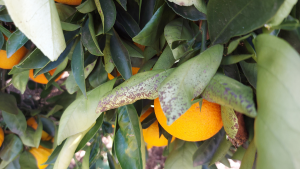As we tumble in June the citrus trees are starting to provide us with sweet juicy fruit. The early fruit can still be quite tart to taste but the run of frosty weather we have had this year will quickly sweeten the fruit and we will find stopping at 1 mandarin or orange hard.
This winter our trees are laden with fruit. This was not the case in 2020. The summer of 2019/20 was a tough one as we experienced some long days and nights of extreme heat and the many days of smoke haze from bush fires. The month of February in 2020 was then unseasonably cool and as a result the citrus trees were tricked into an out of season flowering event and therefore fruited out of season as well. So for our last summer of 2020/21 we put a bit of attention on the citrus to help them back into their wonderful fruiting selves.
This included some extra watering, removing all the out of season fruit (which in a double blow was fruit fly heaven), pruned them back quite a bit and thinned fruit as well. We spread compost around their base and also reapplied the truck bands to stop ant movement. We also made the decision to remove two trees – a pink grapefruit and a lemonade fruit. Removing trees is a hard decision but we were always struggling to eat these and gift them to others. We will plant another navel variety called “karra karra” that has beautiful pink to red, juicy sweet fruit.
The citrus in our garden are pretty low maintenance but there are a couple good maintenance tasks we do regularly. The first is to band the trunks of the trees – at least once a year. This is great way to stop ant movement up and down the trunks and into the branches.
If you have sooty mold or scale problems simply banding the trunk will most often resolve these issues without you having to do any spraying. The ants harvest the sweet exudate that the scale insects secrete (which then also feeds the sooty mold) and they protect this product pretty fiercely from the usual scale insect predators. Once ants have their access cut off the other natural predators can come in and clean up. You can buy the sticky glue from local nurseries or on line. The important thing to remember is to protect the tree trunk with some old towel or sheet, then apply tape and then put the sticky glue onto the tape. Citrus trees have thin bark and can be ring barked easily if you are not careful.
Pruning – after the last of the winter weather has passed by and the risk of frosts gone we prune the trees back. We aim to keep the trees to a height that makes harvesting easy. During the summer any rampant growth is also given a cut back. We aim to avoid having fresh growth bursting out that could be hit by frost – sometimes this still happens though and our lime tree had a bit of tip burning in the last week. As long as the trees is strong and healthy it will be OK.
Finally the last important care we give is as much consistent watering as possible – particularly in the later autumn when the fruit is really filling and conditions can be dry. This helps losing fruit to splitting, ensures the fruit fills and can be as juicy good as possible.
We do fertiliser the trees with compost in spring and a poultry based nitrogen fertilise. Citrus love nitrogen so being generous with compost and a good handful of poultry pellets is really appreciated by these lovelies.



